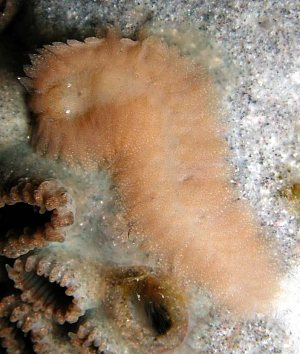Aeolidiopsis ransoni from Hachijo Japan (1).
July 24, 2002
From: Nishina Masayoshi

Dear Bill,
These animals are a kind of Baeolidia such as Baeolidia palythoae Gosliner, 1985. I am not sure whether my animals are B. palythoae or not as I've not yet seen a photo of B. palythoae. I have found both brown speckled animals and white ones which I suspect are different species. I thought the whiter ones were perhaps a colour stage in animals that had not eaten for a while, but the shape of their egg mass looks different to the eggs of the brown spotted one. All of them eat and lay eggs on Palythoa tuberculosa and usually I can find 2 or 3 individuals on the same colony of Palythoa.
The photos here are of two brown speckled animals from the same colony of Palythoa. I have put photos of the white animals and its egg mass in a separate message.
Data: Hachijo Island, Japan, 9 June, 2002, Depth: 6m., Length: 20mm. on Palythoa tuberculosa. Photos: M. Nishina
Best Regards,
Nishina Masayoshi
nishina@wips.co.jp


Dear Nishina,
This is an interesting find. I think both the white and brown animals are the same species, Aeolidiopsis ransoni. Can you have a look at any other photos you have and see if you can see the rhinophores. In A. ransoni they should be smooth. To discuss your message, I gave just prepared some pages on this species and another Palythoa - feeder, Aeolidiopsis harrietae, which is very similar to Terry Gosliner's B. palythoae. In both those species the rhinophores have long papillae. I have discussed whether Aeolidiopsis or Baeolidia are the most appropriate genera for these species in a separate message.
But back to the white and brown animals. I have found this animal at both Lizard Island and Heron Island on the Great Barrier Reef, and it has two colour forms. One, like your animals is translucent with white speckling and a few brown spots, and the other is heavily speckled with dark brown. As you suspected the colour difference is 'food' related. The brown speckled animals retain zooxanthellae from the Palythoa, while the white ones do not. Whether the two colour forms are just phases in the digestive cycle of the slug, or represent distinct populations, one which harbours zooxanthellae and one that doesn't, I don't know. My observations suggested that the brown speckled form was found on the dorsal surface of the Palythoa while the white form was found burrowing just below the skin of the colony and could only be found by breaking off pieces of the colony and leaving them in a dish for a few hours until the white slugs crawled out. I must say that both the white and brown forms are very well camouflaged.
To the difference in the egg mass. It would certainly be worth getting some more information on this. You could be right and have two species here. However it is also possible that the egg ribbon in your separate message is aberrant. Egg ribbons are not always laid perfectly. It would be interesting to see if you can get some photos of more of these egg rbbons to see if they are consistently different. I have spread the information on A. harrietae and A. ransoni over a number of pages so jahve a look at the links on the Fact Sheet.
Best wishes,
Bill Rudman
Related messages
-
Rhinophores of Japanese Aeolidiopsis
From: Nishina Masayoshi, July 25, 2002 -
Egg ribbon of Japanese Aeolidiopsis
From: Nishina Masayoshi, July 25, 2002 -
Aeolidiopsis ransoni from Hachijo Japan (2).
From: Nishina Masayoshi, July 24, 2002 -
Aeolidiopsis ransoni from Great Barrier Reef
From: Bill Rudman, July 24, 2002
